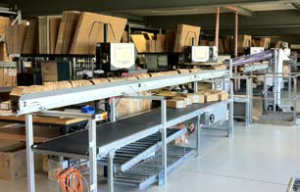It doesn't always help to just read a brochure about how great a product can be: brochures and sales guides are just marketing speak. It's the great sounding content that manufacturers and distributors want you to read and believe. Sometimes it takes some real world applications to really see how these solutions can make a definitive difference in facilities. That's how you can make the decision to make the commitment to trying a new product.
Here are three of those real world solutions proving improvements and savings offered by switching void fill systems to meet the needs of your specific industry.
Integration for a major dealer of commercial vehicle replacement parts
 Reliable product protection with air pillow void fill, plus space-saving, overhead integration.
Reliable product protection with air pillow void fill, plus space-saving, overhead integration.Products: Truck replacement parts
Size: 12 workplaces; space-saving transfer of air cushions through overhead bridge construction
Machine equipment: 6 air pillow machines
Performance per packaging place: 2 minutes per pack (average)
Total performance: 2,000 packs/day (average)
Challenge: This particular company sought new protective packaging for partially heavy, partially scratch sensitive, packaged truck replacement parts. The point of the protective packaging was to fill empty space and pad the products for protection during shipping. The available installation space was extremely small.
Solution: The air cushion with 16 air chambers per film section is very flexible and works well for wrapping sensitive products and the three-layer film better sustains heavy products. The space-saving supply of cushions at the workplace was achieved with a bridge construction. Reliable product protection with the flexible air cushion type, plus space-saving, overhead integration with high-speed machines.
Integration for a direct marketing company
 "We now have a quick and reliable means of providing for protection during transport. We have also profited from a couple of welcome side effects, such as more economical warehousing and tidier work-stations. Protection during transport has improved."
"We now have a quick and reliable means of providing for protection during transport. We have also profited from a couple of welcome side effects, such as more economical warehousing and tidier work-stations. Protection during transport has improved."Products: Workshop supplies, assembly and fasteners
Equipment: Seven automated bagpackers
Production rate per packing station: 26 seconds per shipment (average)
Total production rate: 7800 shipments / day (average)
Challenge: This major retailer has a highly automated central warehouse. The protective packaging system must enable individual packers to process rapidly. The contents of the shipments present a wide variety in terms of protection needed during transport. In some cases, for instance, fragile items are packed together with heavy objects.
Solution: Foam pads secure all articles in place inside the package while also providing heavy objects with sufficient cushioning. In dealing with shipments of individual parcels, there is no way to control what might be placed on top of a shipment during transport. But the foam pads solve this problem by considerably improving the crush strength of cardboard packaging. Produce up to 23 cushions per minute, the supply of foam component materials are delivered to all machines from containers located one floor below which are easily accessible.
Integration for a retail company
 “We require less space and our operations are more flexible, efficient and productive. As our needs grow, we can build on the advances we have already made.”
“We require less space and our operations are more flexible, efficient and productive. As our needs grow, we can build on the advances we have already made.”Products: Watches and jewelry
Size: 16 employees
Equipment: Two chevron-style paper producing machines
Semi-automated: Two conveyor belt systems (belt system 30 ft. and 20 ft.)
Capacity at the packing station: 1 - 3 minutes per shipment (average)
Total capacity: 200 to 250 shipments per day (average)
Challenge: The purpose of the integration is to sustainably increase the productivity of the packing station per square foot of floor space. The machine needs to dynamically adapt to fluctuating workloads. The protective packaging solutions must be provided at 16 work stations. The shipments contain packed watches and jewelry.
Solution: Chevron paper pads efficiently fill the voids. The high-quality look of the paper promotes the brand appearance of the products. Two units are sufficient for the required capacity of protective packaging. Two belt conveyors ensure a constant supply of materials at the packing stations. The packers tear the pads off as needed; materials are re-supplied automatically. If required, a belt can produce a buffer directly in the container.
Maximize your equipment efficiency.
Working with one of our knowledge Packaging Specialists, we offer unique solutions to all your packaging issues. We don't just worry about selling you the box; we're here to service all aspects of your packaging program, including what's inside the box. Choosing the right void fill solution can help you save time and money. And some void fill works better for certain products than do others. But if you don't know, you can't make the right decision.
And that's why you call us.


